Scratch Testing of AlSi12/SiCp Composite Layer with High Share of Reinforcing Phase Formed in the Centrifugal Casting Process
Abstract
1. Introduction
2. Materials and Methods
2.1. Matrix and Reinforcement Components
2.2. Preparation of the Test Material
2.3. Microstructure Examination
2.4. The Scratch Test
3. Results and Discussion
3.1. Composite Layer Microstructure
3.2. Composite Layer Scratch Testing
4. Conclusions
- Susceptibility of the tested AlSi12/SiCp composite layer formed in the centrifugal casting process to scratching depends significantly on the value of force applied to the diamond indenter.
- With the increasing value of the force applied to the diamond indenter, the friction force and friction coefficient values increase significantly, which is evidence of a high resistance of SiC particles to abrasion.
- In the process of the diamond indenter forming a scratch in the AlSi12/SiCp composite layer area, the soft matrix is subjected to smearing, while cracks appear in hard and brittle SiC particles.
- The process of nucleation and propagation of cracks in the course of scratch formation in the AlSi12/SiCp composite layer area is determined by the size and shape of SiC particles and their orientation relative to the scratching direction.
- Analysis of the acoustic emission signal is a useful tool when the scratch test is used to evaluate the degree of SiCp degradation. With the increasing value of force applied to the diamond indenter, the level of acoustic signal emitted by cracking SiC particles also increases, which provides evidence of the intensification of the material degradation process.
Author Contributions
Funding
Conflicts of Interest
References
- Kozioł, M. Mechanical performance of GFRP laminates manufactured from deformed stitched and three-dimensional woven preforms. J. Compos. Mater. 2015, 50, 2617–2631. [Google Scholar] [CrossRef]
- Christin, F.A. Design, Fabrication, and Application of Thermostructural Composites (TSC) like C/C, C/SiC, and SiC/SiC Composites. Adv. Eng. Mater. 2002, 4, 903–912. [Google Scholar] [CrossRef]
- Degischer, H.P.; Prader, P.; Marchi, C.S. “Assessment of Metal Matrix Composites for Innovations” — intermediate report of a European Thematic Network. Compos. Part A: Appl. Sci. Manuf. 2001, 32, 1161–1166. [Google Scholar] [CrossRef]
- Surappa, M.K. Aluminium matrix composites: Challenges and opportunities. Sadhana 2003, 28, 319–334. [Google Scholar] [CrossRef]
- Macke, A.; Schultz, B.F.; Rohatgi, P. Metal Matrix Composites offer the Automotive Industry an Opportunity to Reduce Vehicle Weight, Improve Performance. Adv. Mater. Proc. 2012, 12–23. [Google Scholar]
- Kurtyka, P.; Rylko, N.; Tokarski, T.; Wójcicka, A.; Pietras, A. Cast aluminium matrix composites modified with using FSP process – Changing of the structure and mechanical properties. Compos. Struct. 2015, 133, 959–967. [Google Scholar] [CrossRef]
- Wieczorek, J. Tribological Properties and a Wear Model of Aluminium Matrix Composites - SiC Particles Designed for Metal Forming. Arch. Met. Mater. 2015, 60, 111–115. [Google Scholar] [CrossRef]
- Vencl, A.; Rac, A.; Bobic, I. Tribological Behaviour of Al-Based MMCs and their Application in Automotive Industry. Trib. Ind. 2004, 26, 3–4, 31–38. [Google Scholar]
- Prasad, S.; Asthana, R. Aluminum Metal–Matrix Composites for Automotive Applications: Tribological Considerations. Tribol. Lett. 2004, 17, 445–453. [Google Scholar] [CrossRef]
- Dyzia, M. AlSi7Mg/SiC and Heterophase SiCP+CG Composite for Use in Cylinder-Piston System of Air Compressor. Solid State Phenom. 2011, 176, 49–54. [Google Scholar] [CrossRef]
- A Taha, M. Practicalization of cast metal matrix composites (MMCCs). Mater. Des. 2001, 22, 431–441. [Google Scholar] [CrossRef]
- Monaghan, J. Factors Affecting the Machinability of Al/SiC Metal-Matrix Composites. Key Eng. Mater. 1997, 138, 545–574. [Google Scholar] [CrossRef]
- Wieczorek, J.; Dyzia, M.; Dolata, A.J. Machinability of Aluminium Matrix Composites. Solid State Phenom. 2012, 191, 75–80. [Google Scholar] [CrossRef]
- Huang, S.; Guo, L.; He, H.; Xu, L. Study on characteristics of SiCp/Al composites during high-speed milling with different particle size of PCD tools. Int. J. Adv. Manuf. Technol. 2017, 95, 2269–2279. [Google Scholar] [CrossRef]
- Davim, J.P.; Baptista, A.M. Relationship between cutting force and PCD cutting tool wear in machining silicon carbide reinforced aluminium. J. Mater. Process. Technol. 2000, 103, 417–423. [Google Scholar] [CrossRef]
- Müller, F.; Monaghan, J. Non-conventional machining of particle reinforced metal matrix composite. Int. J. Mach. Tools Manuf. 2000, 40, 1351–1366. [Google Scholar] [CrossRef]
- Gao, J.; Wang, C. Modeling the solidification of functionally graded materials by centrifugal casting. Mater. Sci. Eng. A 2000, 292, 207–215. [Google Scholar] [CrossRef]
- Drenchev, L.; Sobczak, J.; Malinov, S.; Sha, W. Numerical simulation of macrostructure formation in centrifugal casting of particle reinforced metal matrix composites. Part 1: Model description. Model. Simul. Mater. Sci. Eng. 2003, 11, 635–649. [Google Scholar] [CrossRef]
- Rajan, T.P.D.; Pai, B.C. Formation of solidification microstructures in centrifugal cast functionally graded aluminum composites. Trans. Indian Inst. Met. 2009, 62, 383–389. [Google Scholar] [CrossRef]
- Sobczak, J.; Drenchev, L. Metallic Functionally Graded Materials: A Specific Class of Advanced Composites. J. Mater. Sci. Technol. 2013, 29, 297–316. [Google Scholar] [CrossRef]
- Rajan, T.P.D.; Pai, B.C. Processing of Functionally Graded Aluminium Matrix Composites by Centrifugal Casting Technique. Mater. Sci. Forum 2011, 690, 157–161. [Google Scholar] [CrossRef]
- Huang, X.; Liu, C.; Lv, X.; Liu, G.; Li, F. Aluminum alloy pistons reinforced with SiC fabricated by centrifugal casting. J. Mater. Process. Technol. 2011, 211, 1540–1546. [Google Scholar] [CrossRef]
- Dolata, A.J. Hybrid Comopsites Shaped by Casting Methods. Solid State Phenom. 2013, 211, 47–52. [Google Scholar] [CrossRef]
- Dolata, A.J.; Golak, S.; Ciepliński, P. The Eulerian multiphase model of centrifugal casting process of particle reinforced Al matrix composites. Composites Theory and Practice 2017, 17, 200–205. [Google Scholar]
- Dolata, A.J.; Dyzia, M.; Wieczorek, J. Tribological Properties of Single (AlSi7/SiCp, AlSi7/GCsf) and Hybrid (AlSi7/SiCp + GCsf) Composite Layers Formed in Sleeves via Centrifugal Casting. Materials 2019, 12, 2803. [Google Scholar] [CrossRef] [PubMed]
- Wang, K.; Jiang, T.; Huang, Z.; Xue, H.; Yang, D.; Zhu, Z. Mechanical and thermal expansion properties of SiCp/ZAlSi9Mg composites produced by centrifugal casting. J. Wuhan Univ. Technol. Sci. Ed. 2016, 31, 197–203. [Google Scholar] [CrossRef]
- Zhao, X.; Gong, Y.; Cai, M.; Han, B. Numerical and Experimental Analysis of Material Removal and Surface Defect Mechanism in Scratch Tests of High Volume Fraction SiCp/Al Composites. Materials 2020, 13, 796. [Google Scholar] [CrossRef]
- Lafaye, S.; Troyon, M. On the friction behaviour in nanoscratch testing. Wear 2006, 261, 905–913. [Google Scholar] [CrossRef]
- Kitzig-Frank, H.; Tawakoli, T.; Azarhoushang, B.; Heike, K.-F.; Taghi, T.; Bahman, A. Material removal mechanism in ultrasonic-assisted grinding of Al2O3 by single-grain scratch test. Int. J. Adv. Manuf. Technol. 2017, 91, 2949–2962. [Google Scholar] [CrossRef]
- Feng, P.; Liang, G.; Zhang, J. Ultrasonic vibration-assisted scratch characteristics of silicon carbide-reinforced aluminum matrix composites. Ceram. Int. 2014, 40, 10817–10823. [Google Scholar] [CrossRef]
- Zheng, W.; Zhou, M. Experimental Study on Ultrasonic Vibration-Assisted Scratch of SiCp/Al Composite. Key Eng. Mater. 2015, 667, 68–74. [Google Scholar] [CrossRef]
- Kong, X.; Wang, B.; Wang, M.; Zheng, Y.; Ma, S.; Yang, L. Microscratch characteristic and deformation mechanism of SiC particle-reinforced composites at elevated temperatures. Adv. Compos. Lett. 2020, 29, 1–11. [Google Scholar] [CrossRef]
- Dolata, A.J.; Dyzia, M. Aspects of fabrication aluminium matrix heterophase composites by suspension method. IOP Conf. Series: Mater. Sci. Eng. 2012, 35, 012020. [Google Scholar] [CrossRef]
- Dyzia, M. Aluminum Matrix Composite (AlSi7Mg2Sr0.03/SiCp) Pistons Obtained by Mechanical Mixing Method. Materials 2017, 11, 42. [Google Scholar] [CrossRef] [PubMed]
- Soltani, S.; Khosroshahi, R.A.; Mousavian, R.T.; Jiang, Z.; Boostani, A.F.; Brabazon, D. Stir casting process for manufacture of Al–SiC composites. Rare Met. 2015, 36, 581–590. [Google Scholar] [CrossRef]
- Hashim, J.; Looney, L.; Hashmi, M. Metal matrix composites: Production by the stir casting method. J. Mater. Process. Technol. 1999, 92, 1–7. [Google Scholar] [CrossRef]
- Dolata, A.J.; Dyzia, M.; Jaworska, L.; Putyra, P. Cast Hybrid Composites Designated for Air Compressor Pistons. Arch. Met. Mater. 2016, 61, 705–708. [Google Scholar] [CrossRef]
- Dolata, A.J. Tribological Properties of AlSi12-Al2O3 Interpenetrating Composite Layers in Comparison with Unreinforced Matrix Alloy. Materials 2017, 10, 1045. [Google Scholar] [CrossRef]
- Nagarajan, S.; Dutta, P.; Surappa, M.K. The effect of SiC particles on the size and morphology of eutectic silicon in cast A356/SiCp composites. Comp. Sci. Tech. 1999, 59, 897–902. [Google Scholar] [CrossRef]
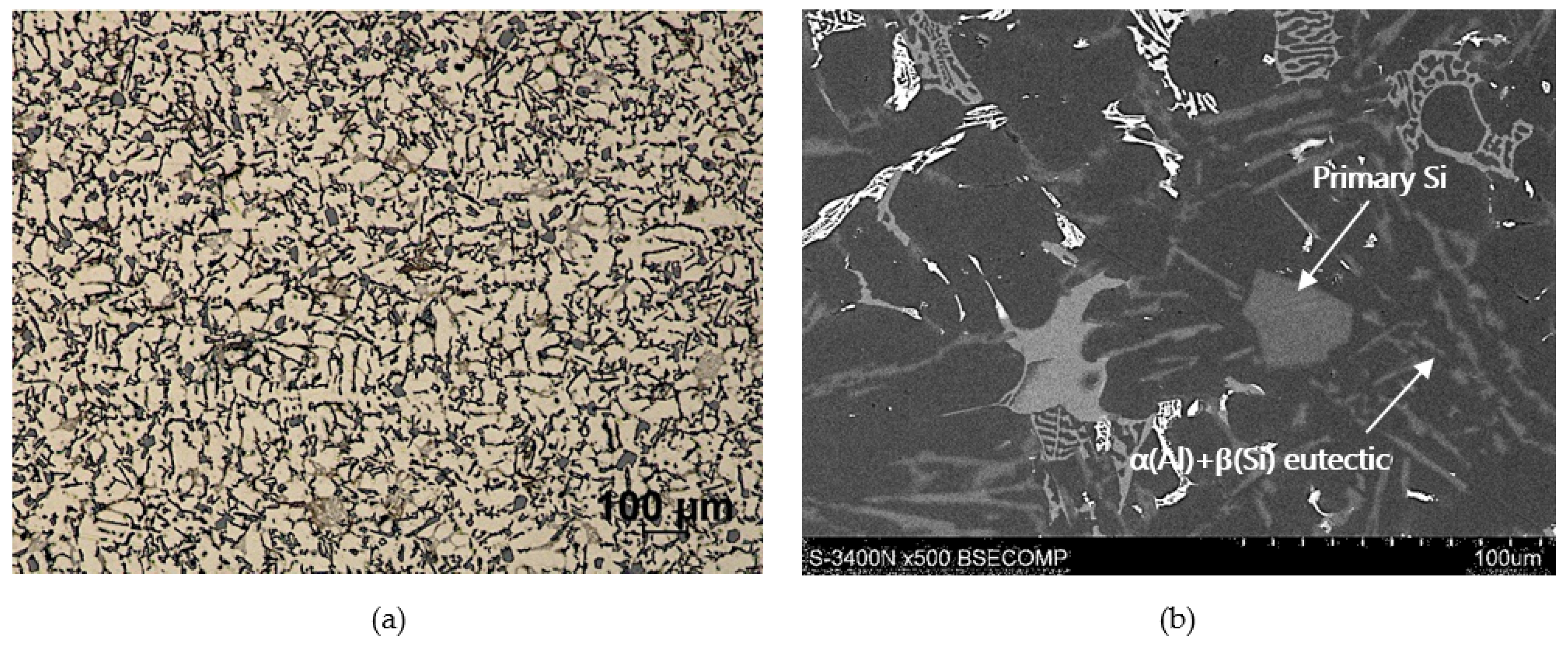
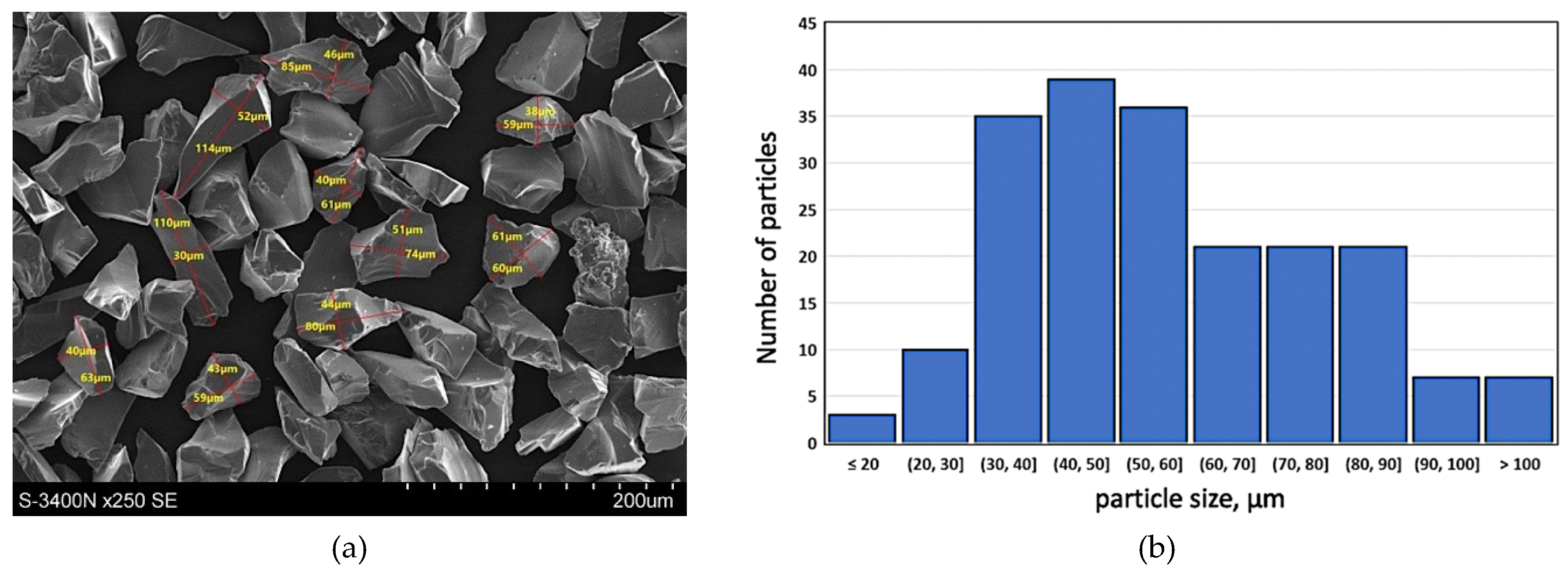
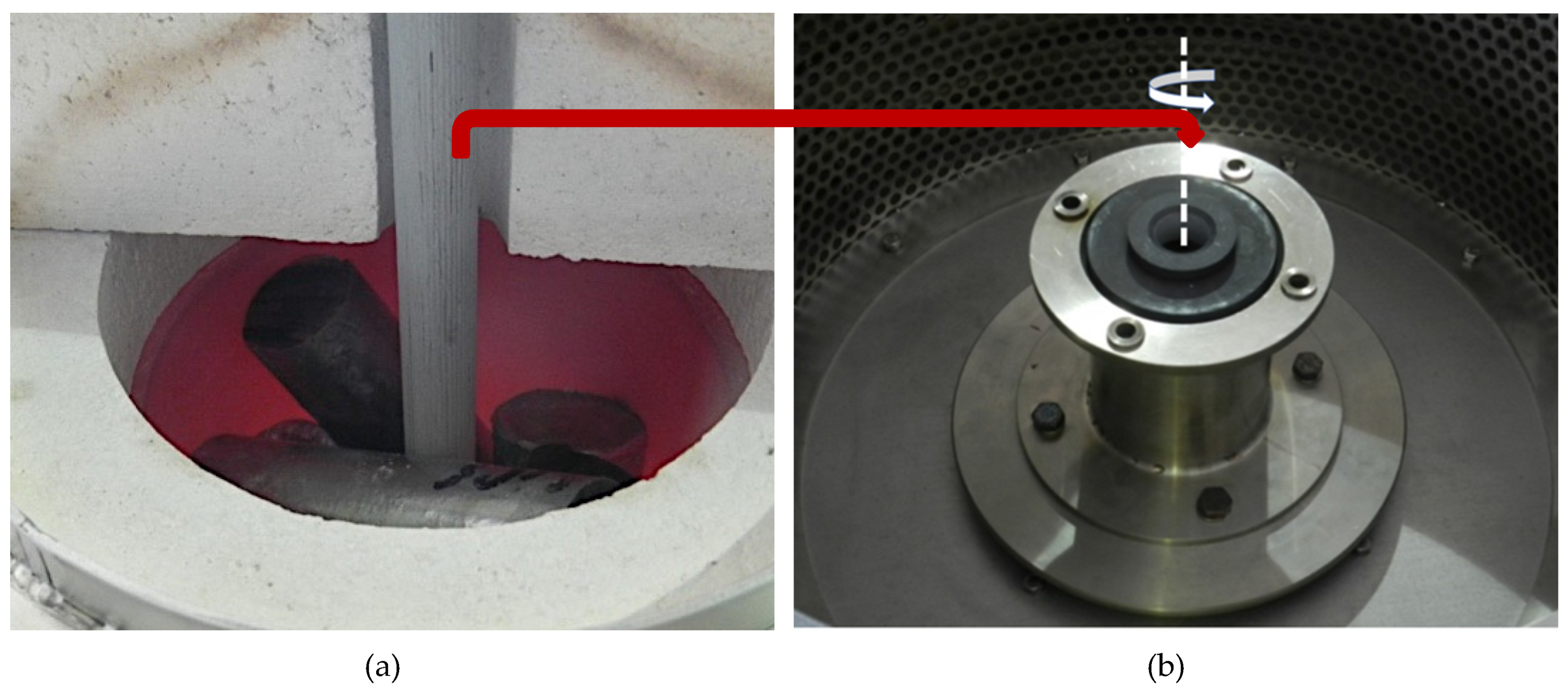
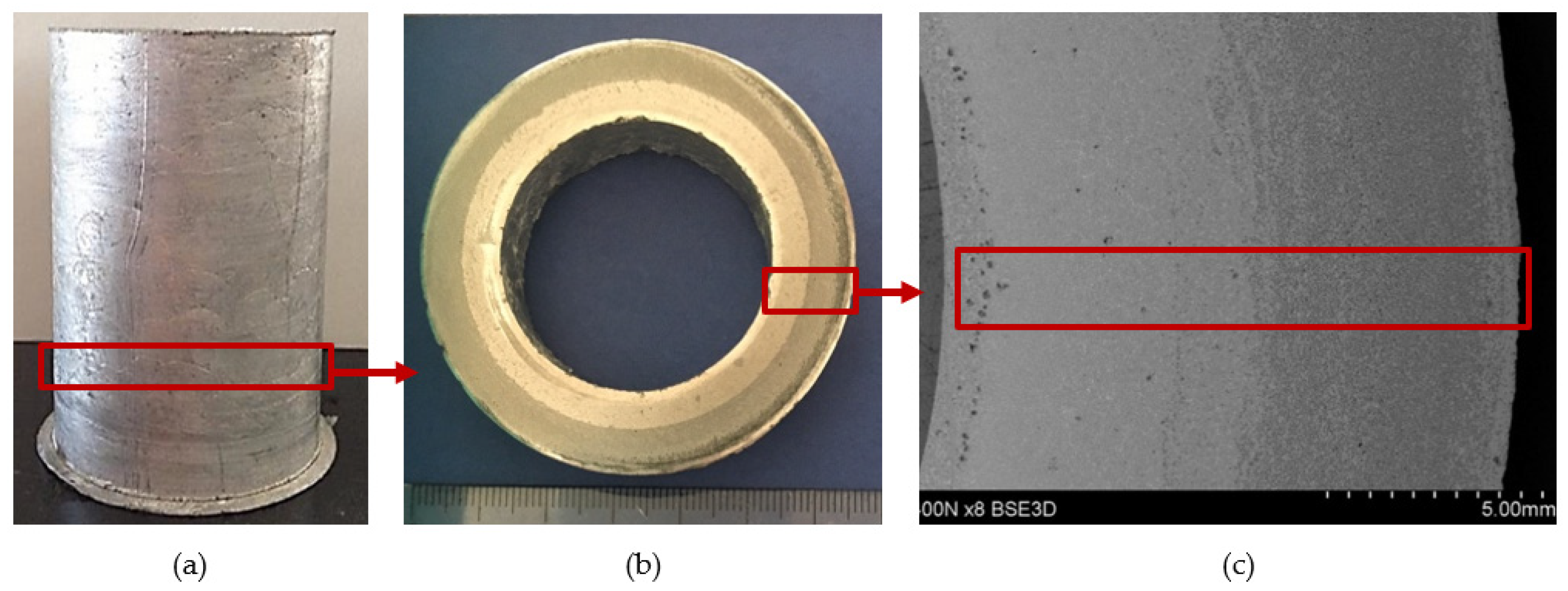

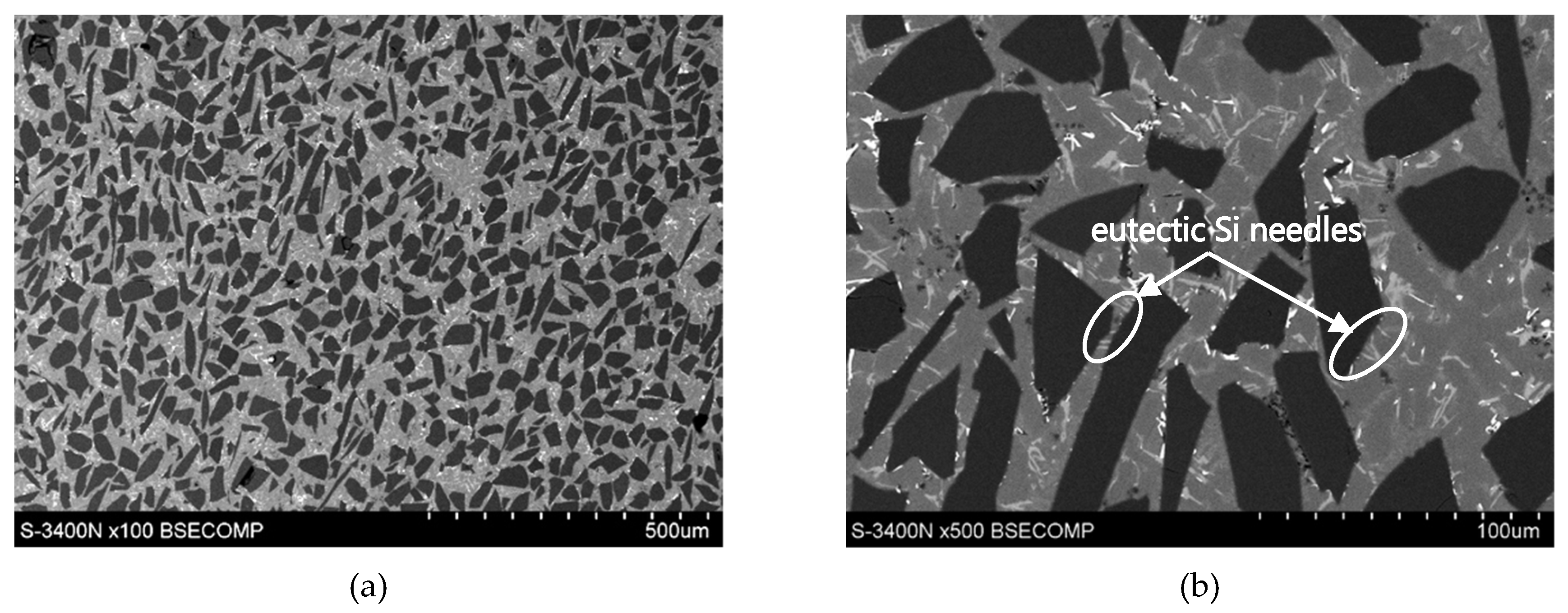
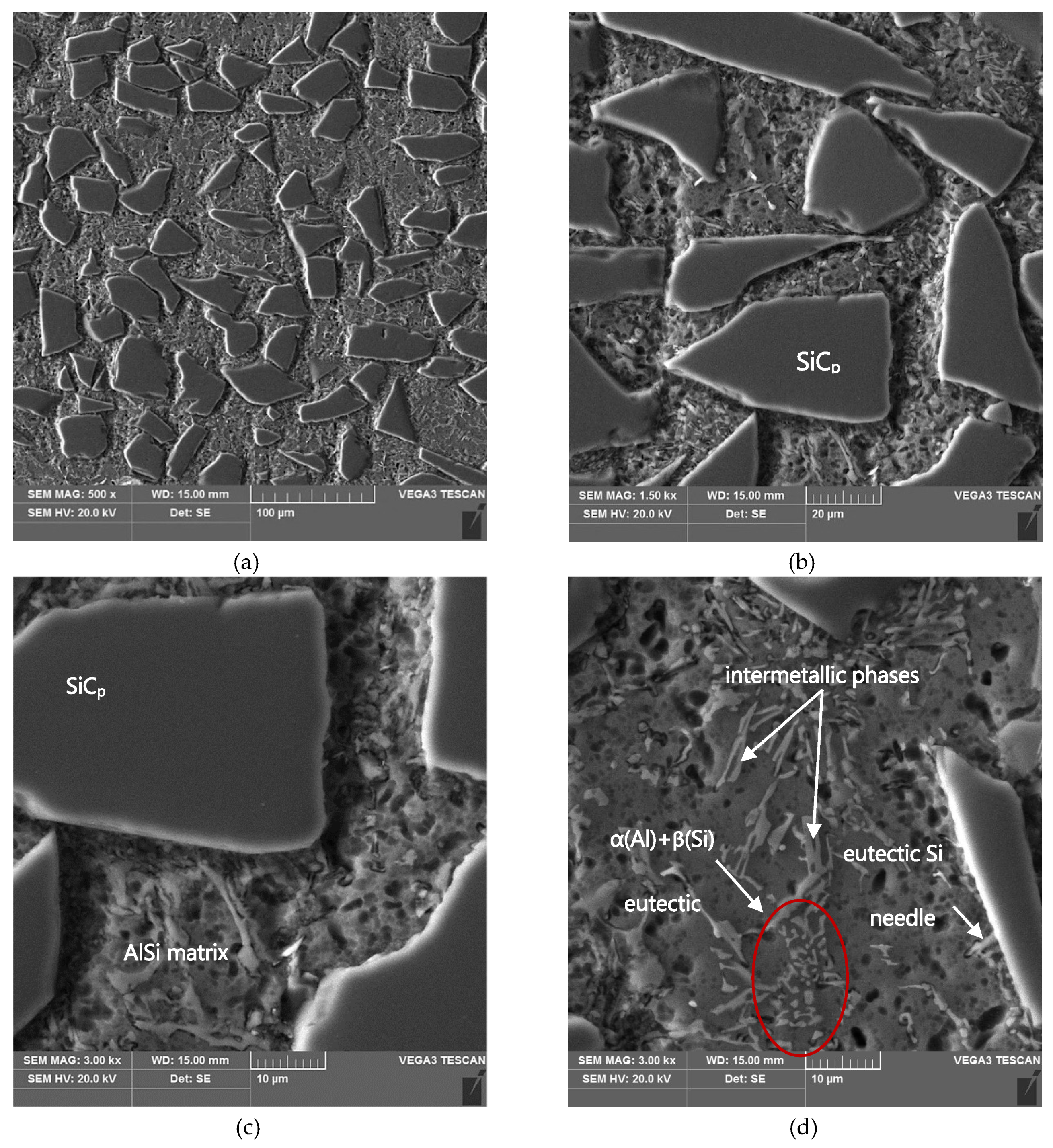
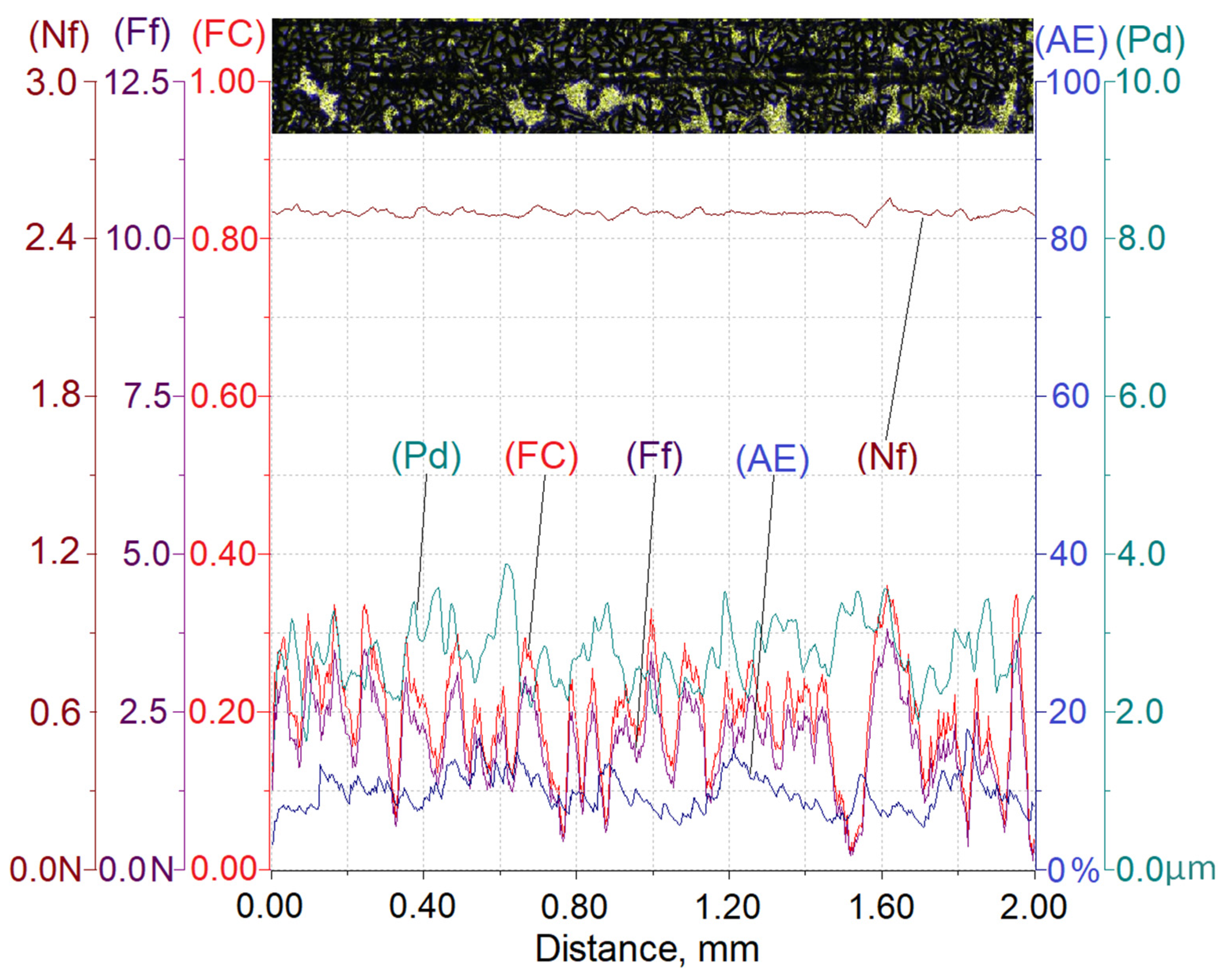
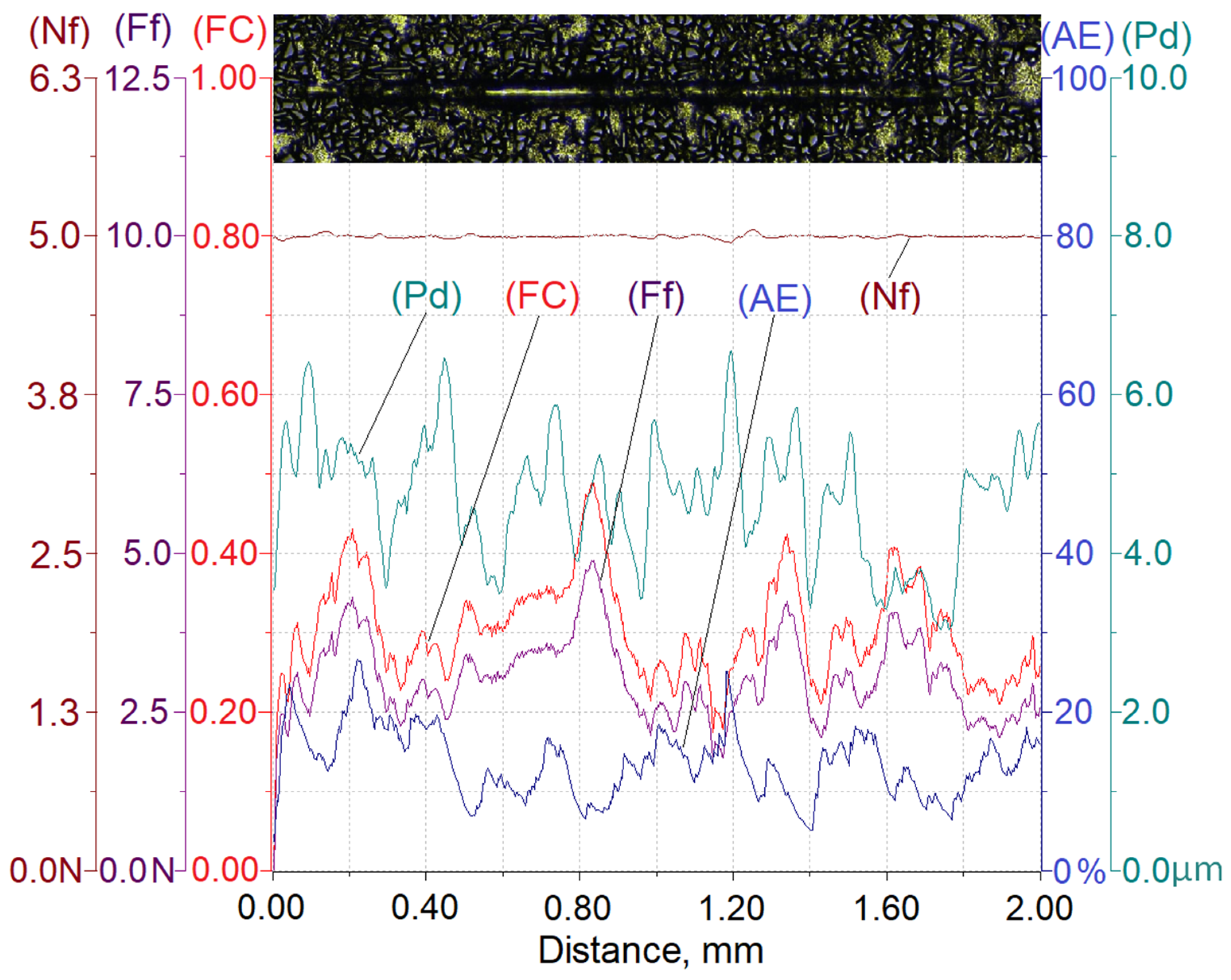
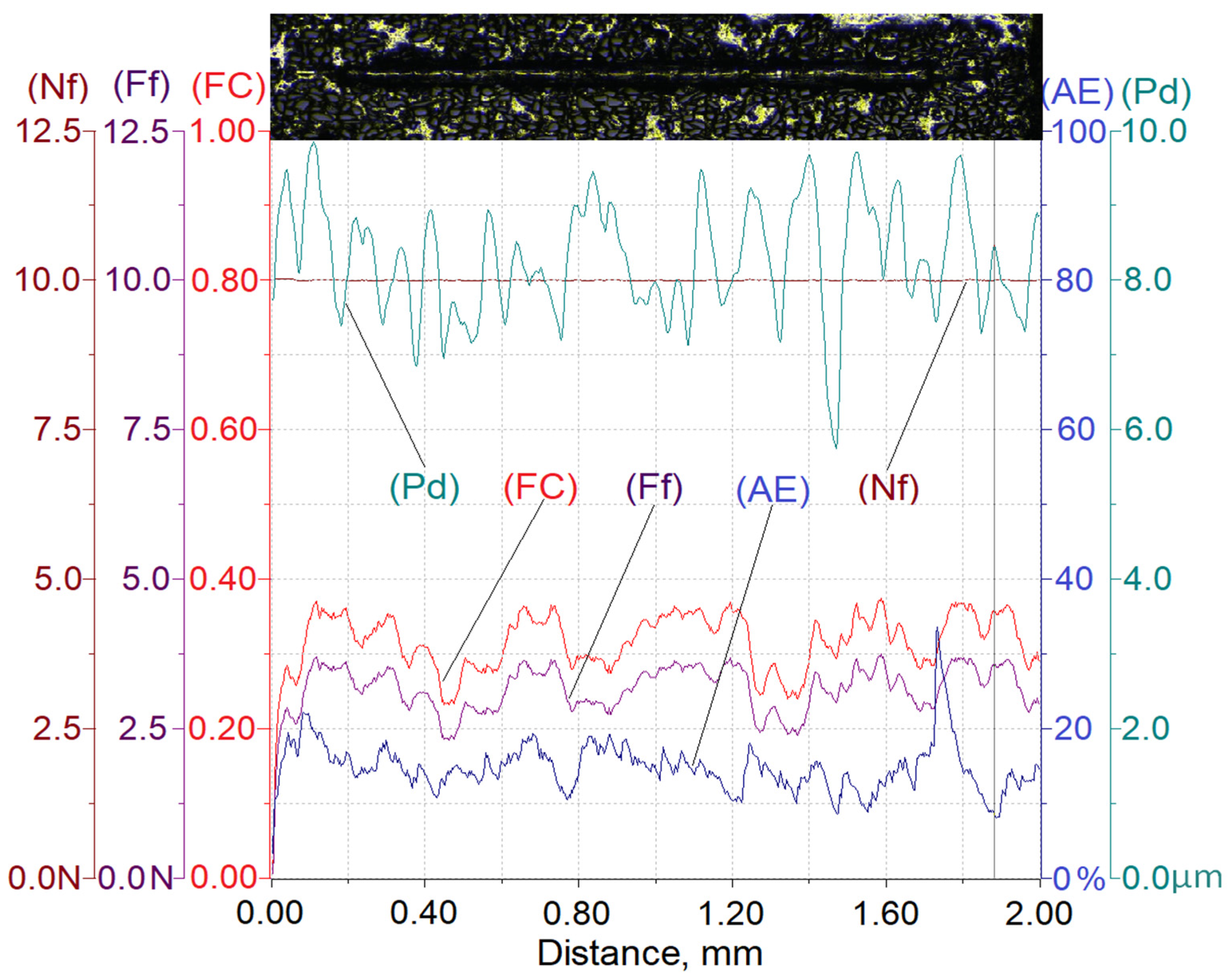

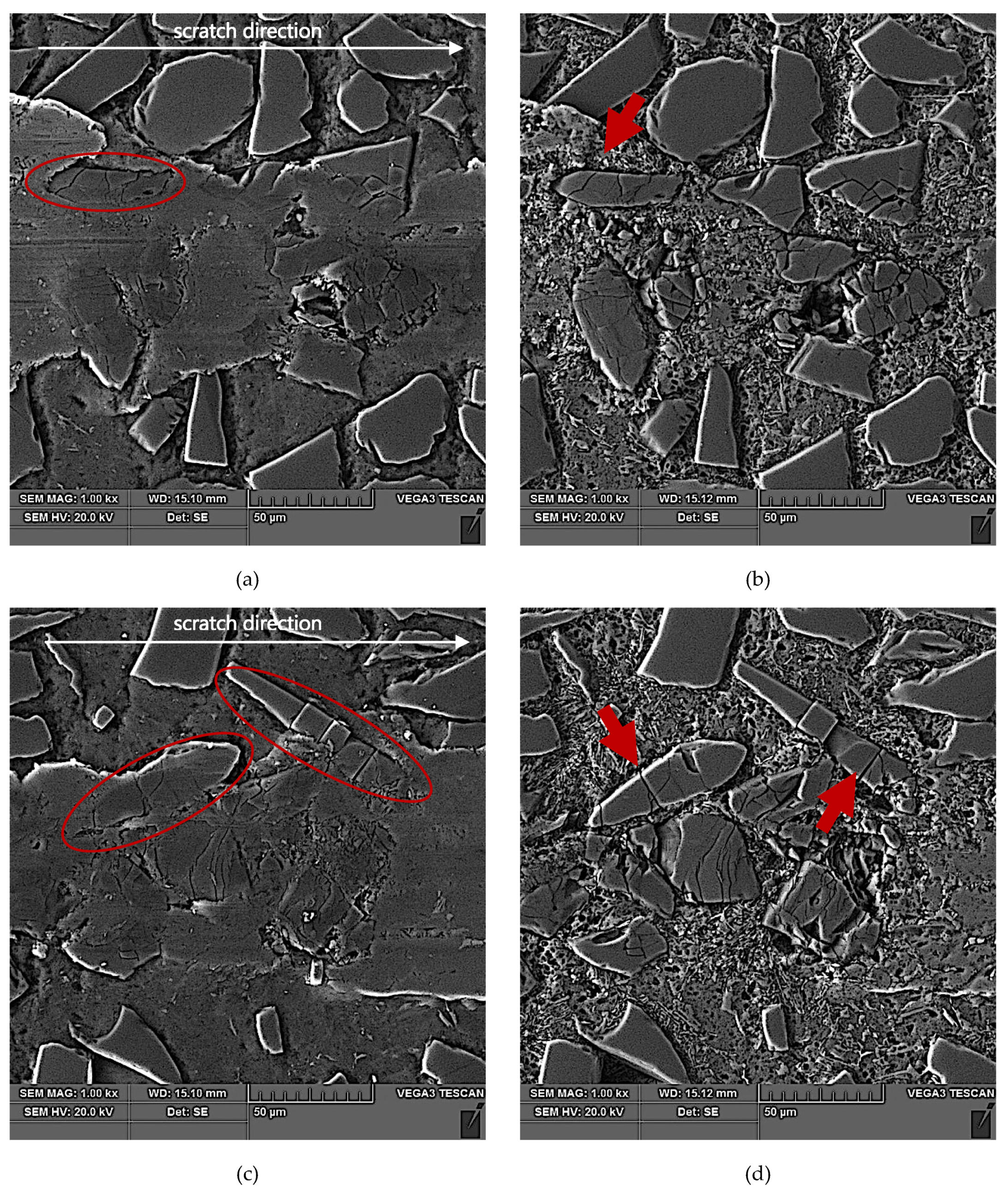
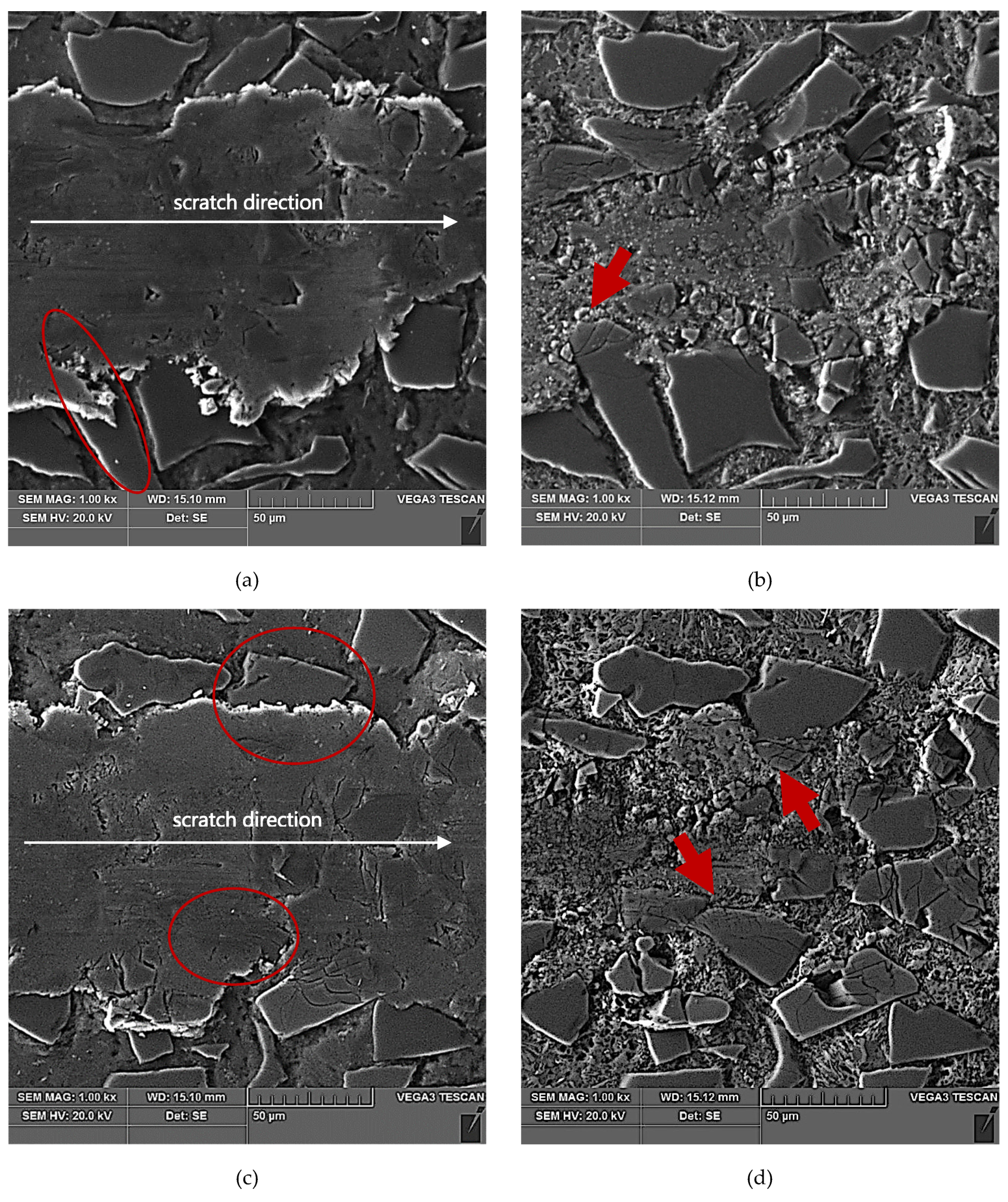

| Si | Fe | Cu | Zn | Mn | Ti | Mg | Ni | Al | |
|---|---|---|---|---|---|---|---|---|---|
| AlSi12CuNiMg* | 11.70 | 0.43 | 1.21 | 0.20 | 0.18 | 0.04 | 1.45 | 1.19 | Bal. |
| Range of Pouring Temperature (°C) | Centrifugal Mold Temperature (°C) | Centrifugal Mold Diameter (mm) | Centrifugal Mold Rotational Speed (rpm) |
|---|---|---|---|
| 720–740 | 350 | 60 | 3000 |
| Parameter | Normal Force (N) | |||
|---|---|---|---|---|
| 2.5 | 5 | 10 | ||
| Pd (μm) | min. | 1.64 | 3.05 | 5.76 |
| max. | 3.88 | 6.55 | 9.84 | |
| average | 2.76 | 4.8 | 7.80 | |
| Ff (N) | min. | 0.07 | 0.67 | 2.43 |
| max. | 0.91 | 2.41 | 3.84 | |
| average | 0.49 | 1.54 | 3.13 | |
| FC | min. | 0.028 | 0.135 | 0.243 |
| max. | 0.364 | 0.428 | 0.384 | |
| average | 0.196 | 0.308 | 0.313 | |
| AE (%) | min. | 5.55 | 5.20 | 8.21 |
| max. | 17.85 | 26.59 | 33.24 | |
| average | 11.70 | 15.89 | 20.72 | |
© 2020 by the authors. Licensee MDPI, Basel, Switzerland. This article is an open access article distributed under the terms and conditions of the Creative Commons Attribution (CC BY) license (http://creativecommons.org/licenses/by/4.0/).
Share and Cite
Dolata, A.J.; Mróz, M.; Dyzia, M.; Jacek-Burek, M. Scratch Testing of AlSi12/SiCp Composite Layer with High Share of Reinforcing Phase Formed in the Centrifugal Casting Process. Materials 2020, 13, 1685. https://doi.org/10.3390/ma13071685
Dolata AJ, Mróz M, Dyzia M, Jacek-Burek M. Scratch Testing of AlSi12/SiCp Composite Layer with High Share of Reinforcing Phase Formed in the Centrifugal Casting Process. Materials. 2020; 13(7):1685. https://doi.org/10.3390/ma13071685
Chicago/Turabian StyleDolata, Anna Janina, Marek Mróz, Maciej Dyzia, and Magdalena Jacek-Burek. 2020. "Scratch Testing of AlSi12/SiCp Composite Layer with High Share of Reinforcing Phase Formed in the Centrifugal Casting Process" Materials 13, no. 7: 1685. https://doi.org/10.3390/ma13071685
APA StyleDolata, A. J., Mróz, M., Dyzia, M., & Jacek-Burek, M. (2020). Scratch Testing of AlSi12/SiCp Composite Layer with High Share of Reinforcing Phase Formed in the Centrifugal Casting Process. Materials, 13(7), 1685. https://doi.org/10.3390/ma13071685








